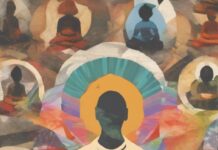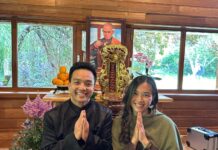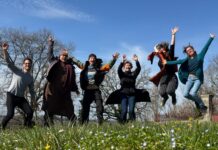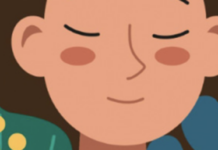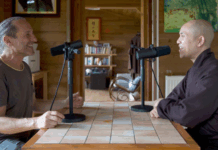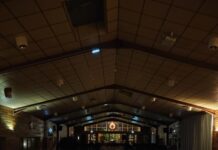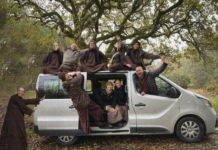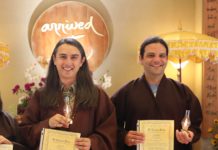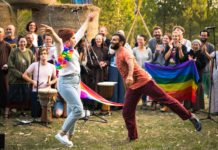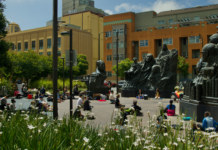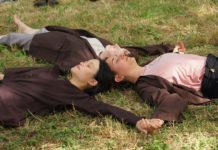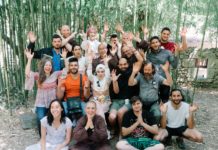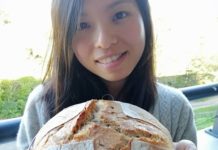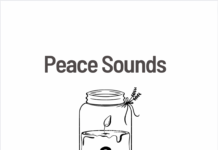Insights from a year living in Plum Village
By Doran from Wake Up Brighton
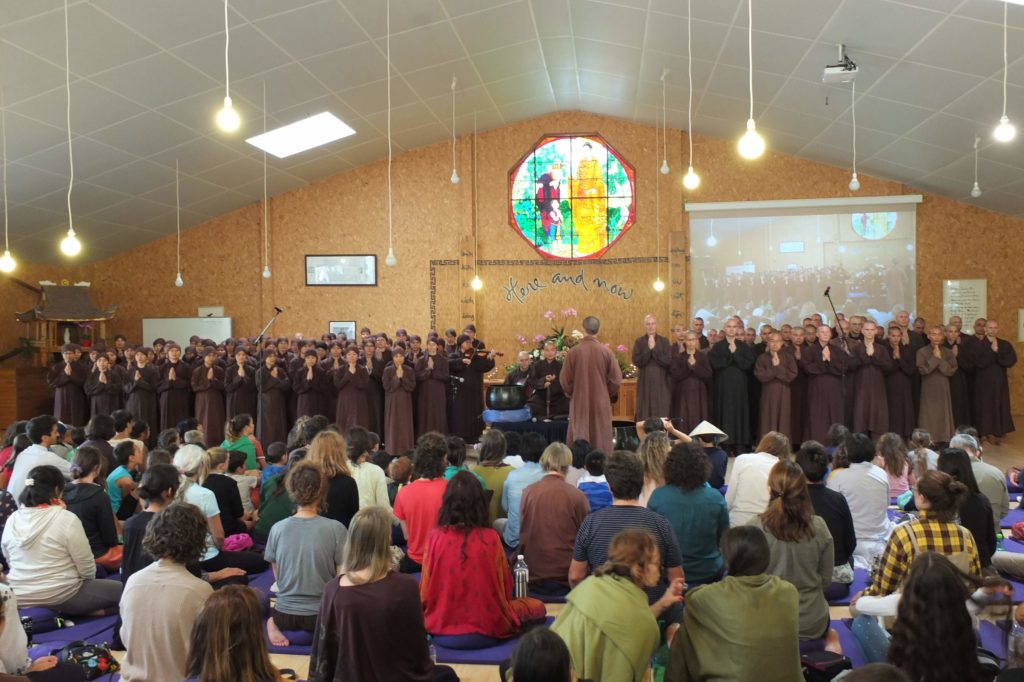
It’s 4 a.m. I can feel my heart beating and my whole body tensing up. Although I’m lying in bed, it feels like my body is floating some imperceptible distance above the warmth and comfort of the mattress. My mind spins like a fairground ride, falling into mental wormholes of anxiety and obsession, lost in a mental maze of fantasies and yearnings about the working day ahead.
I need to put my mental health first and I need to take a radical step to change my situation.
I’m jacked up on cortisol, the stress hormone, and I won’t get much respite before daylight breaks out around 7 a.m. By then, I will be exhausted from the obsessive rumination and will be thankful for the relief of sleep for another two or three hours. Arriving at work later in the morning, I will have neither the enthusiasm nor the energy to make real any of the crazed plans my delirious imagination threw at me in the middle of the night.
It’s 2014 and I am living and working in Germany, coming to the apex of what I will later describe as a burnout. The causes are numerous: lack of support, isolation, an unhealthy obsession with achievement and perfection, and two romantic catastrophes in quick succession. I have considered asking my boss if I can work part-time, but I increasingly realise it wouldn’t be enough. The wormholes of obsession are becoming part of my waking life too, and are beginning to manifest as periodic episodes of debilitating pain and nausea. I need to put my mental health first and I need to take a radical step to change my situation.
For several years, I have been connected to the Plum Village tradition—meditating, going to retreats and facilitating Wake Up groups. The decision has already been made—if now isn’t a good time to go to Plum Village, then I don’t know when is! I write my letter of resignation.
1. Change the world: Be lazy, be kind.
During my time at Plum Village and in the years since then, I have been absorbing some valuable insights. The first is to do with effort and fulfilment. At school we all learn that to get where you want to be in life and to be successful, you have to work hard, right? Wrong.
“Each one of us has to ask ourselves: What do I really want? Do I really want to be Number One? Or do I want to be happy? If you want success, you may sacrifice your happiness for it. You can become a victim of success, but you can never become a victim of happiness.”
— Thich Nhat Hanh
I have been practising the art of how to strive and how to achieve my whole life, excelling at school and university, putting in weekends at work, and never settling for less than perfection. Compared with this world of hype and ambition, Plum Village feels like a bit of a let down. There’s not much buzz of activity, no sense that this is the central hub of an Engaged Buddhist movement calling for a “collective awakening” that can transform society.
People drift aimlessly around and sometimes stop for friendly chats or cups of tea together. How could anything world-changing ever come from somewhere so… lazy?
Despite the culture shock, during the first few weeks of my time at Plum Village, I am in a blissful haze, with abundant time and space to take care of myself and touch a clearer sense of freedom than I have felt in a long while. Although the honeymoon doesn’t last, this is an experience and a way of living that I return to again and again as I settle into life there.
All of the normal complications of life are stripped away—no job, no rent, no internet, and, for much of the time, no women either. At some level, there is no choice either—everyone in the community is expected to follow a shared schedule of mindfulness practice.
The encouragement is to enjoy the daily activities of mindful sitting, walking, eating, and working. The spirit is of ease and simplicity, dropping the complication of striving and touching the joy of a body and mind which easefully, lazily breathe and walk all of their own accord. Easy to say, not always so easy to do.
Together as a Sangha, we learn how to touch the happiness and freedom we have right here, right now, which no one can take away from us. That itself is a revolutionary act that can change the world.
2. In habits we make our home, but meanwhile the world outside beckons.
Being in Plum Village is a bit like being stuck in the infinite time loop of Groundhog Day, that 90s gem of a movie (starring Bill Murray and Andie MacDowell). For those who haven’t seen it (watch it now), it’s a spiritually-tinged rom com about a reporter dispatched to a small nowhere-special town, who is condemned to live the same day over and over again. At first, he’s infuriated by it all, but in the end he understands the potential of his situation and learns to change himself, help the people around him, and win the heart of his dream lady.
My experience of Plum Village was a bit like that, minus the lady, and minus the groundhog (though there’s no shortage of resident rodents). The daily, repetitive schedule of mindfulness practice functioned like a mirror, reflecting back to me all the habitual ways in which I was thinking, acting and speaking. Because the schedule is so repetitive, I had less recourse to many of the usual stories and dramas about how I felt this way because of what he or she said, or because of that weird thing that happened. Instead, I begin to see how I made my world from the raw materials of experience, and how I retell myself my own favourite stories and play the same games again and again and again… in short, how I was re-living my beloved habits.
There is a Zen story about a man riding a horse that is galloping very quickly. Another man, standing alongside the road, yells at him, “Where are you going?” and the man on the horse yells back, “I don’t know. Ask the horse.” I think that is our situation. We are riding many horses that we cannot control. — Thich Nhat Hanh
Strangely, the repetitiveness sometimes also worked the other way, as for dear old Bill in the movie. The events of the day seemed identical—same breakfast, same activities, same place, same teachings—but everything was magically different. Life glided through my awareness freely and flowers seemed to wink at me from amidst the grasses. People who were invisible or uninteresting to me suddenly become alive, fascinating, real.
We all have these experiences on a good day, but the space and gentle pace of Plum Village gave more opportunities to me to understand why. For me, it was often that I had surrendered to the unfolding mystery of the day. And in the pregnant space of mystery, life rushed in gladly.
3. I’m not really here most of the time.
Some of the occasions of mindful encounter I remember the best are in apparently unremarkable situations. Passing a beautiful tree standing in a courtyard, I become captivated by the unfathomable depth of its expression. The more I look, the more I find. I am tumbling, swimming into a magical unfolding of this living relationship between me and the tree. Played out across its branches, leaves, buds and flowers, I see the tree expressing the dance of its perpetual movement.
“The most precious gift we can offer others is our presence. When mindfulness embraces those we love, they will bloom like flowers.” — Thich Nhat Hanh
I see how this tree is inextricably connected with the place in which it has grown—its form and self-expression mirror the influences it has received from sunshine, rain, earth and shelter. On a normal day, the tree might register in my thoughts for a split-second, before being deemed “uninteresting”; with stable mindfulness, I am really here to “fall into” an encounter with the tree, and it is profoundly beautiful.
Another experience comes eating food in silence with a group of fellow retreatants. All of a sudden, I am struck by the ineffable wonder of the fact that we are here together as humans, enjoying this simple and necessary act of eating. I have taken but a few morsels into my mouth, but I have hardly felt so full in my whole life. My heart expands in deep satisfaction and gratitude for our being alive, being supported and nourished by the food laid out in front of us. I have a deep appreciation, too, of the intimacy that being together in silence awakens in us. We’re stripped of all our stories, our names, our to-do lists, and in that nakedness our shared humanity shines through brilliantly.
4. No Plum Village? No matter. Intention is what counts.
Living at Plum Village was certainly the best way to shatter all my illusions about how perfect everything would be for my practice if I just had the time to meditate four times a day, regular teachings from monks, or more time to relax and take it easy.
Of course, these things do help and that is exactly why monasteries exist. The rules and schedules by which monastics live have evolved over millennia to provide excellent conditions in which the practice can deepen and the beautiful qualities of presence and compassion can flower daily (but the truth is, these are often hard-won through challenging times).
Crucially, the North Star around which these good conditions constellate is that of intention. Even living in a monastery, where I was continually reminded, reoriented, and redirected towards mindfulness practice, I found that complacency is all too seductive and easy. I certainly spent much of my time its enticing embrace, and I understand better now why that happened. Without a deeply rooted sense of intention, it is easy to waver from the path. As much in a monastery as anywhere else, “tomorrow” can often seem like a better time to practice than today! And tomorrow never quite arrives…
I remember one monastic recounting the steps that led to his decision to ordain. He was describing how he wasn’t completely sure if monasticism was the path for him, so he went to Thay to pose the question, “How certain to do I need to be in order to pursue the life of a monastic?” The answer came swiftly: “You need to be 110% sure!” This was not the answer that the young would-be monastic was hoping for, for sure (fortunately, he ordained anyway). But the message from Thay is clear—a strong intention is the very bedrock of a fruitful practice.
Since leaving Plum Village, I have appreciated even more deeply how vital a clear intention is to my practice. Intention is not just the sense of motivation itself; it is also the answer to why we even practice in the first place. For each individual this is different, emerging organically from their culture, their life history, their vision of what is most beautiful.
Clarifying our intention and keeping it alive day-by-by is an ongoing process of exploring in our heart our responses to questions such as, “What do I feel is the deepest gift I can offer myself and the world? What can I nourish that can best support me and the world through hard times and good times?” These are just some questions that speak to me, so you may discover other questions that speak more deeply to you.
Three years on since I left Plum Village, and I am still receiving insights from my time there. The burnout is far behind me, but its echo lives on, reminding me to be careful when I work and to let go of unhealthy obsessions. So I offer these reminders as much to myself as to you, in the hope that we all can keep our deepest and most beautiful intentions alive, and learn how to live with more ease, presence, and freedom, wherever we find ourselves.
Reprinted with permission from Doran. To read a longer version of this article, click here.


